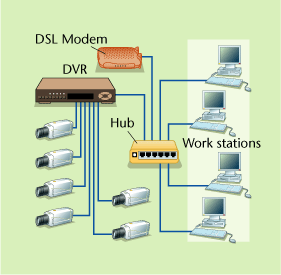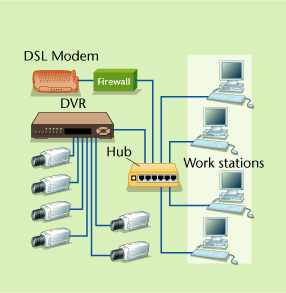1. You cannot connect analog CCTV cameras to a digital video recorder (DVR).
a. True
b. False
2. Which of the following factors affects the storage capacity of a DVR?
a. Frame rate
b. Image resolution
c. Compression technique
d. Storage media (disk) size
e. All of the above
3. A digital video image can be:
a. printed on a standard printer.
b. e-mailed over the internet.
c. saved to a CD or DVD.
d. Any of the above
e. None of the above
4. When referring to digital CCTV, what does the term POE mean?
a. Pixel over sampling event
b. Power over Ethernet
c. Photographic origin example
d. None of the above
5. Cat 5e cable splices should be soldered and taped.
a. True
b. False
6. What type of jack is used to connect a DVR to an Ethernet-based LAN?
a. RJ-11
b. RJ-31X
c. RJ-38X
d. RJ-45
e. Any of the above
7. All DVRs can support external data storage media.
a. True
b. False
8. All codecs offer the same image data reduction.
a. True
b. False
9. Which of the following offers the greatest digital video storage capacity?
a. 3.5 floppy disk
b. CD-ROM
c. CD-RAM
d. DVD
10. All DVRs use some version of the Windows operating system.
a. True
b. False
11. Which of the following features are available with digital recording systems?
a. Face capture and recognition
b. License plate capture and recognition
c. POS/ATM transaction monitoring
d. Movement tracking
e. All of the above
12. Level 0 RAID storage systems incorporate redundancy.
a. True
b. False
13. Integrating DVRs with alarm or access control systems can only be accomplished by using output relays.
a. True
b. False
14. Generally speaking, 10 fps is considered the standard for real-time video.
a. True
b. False
15. Which of the following cannot be used with a digital video recording system?
a. PTZ cameras
b. Auto-iris lens
c. Varifocal lens
d. Any of the above
e. None of the above

What’s Wrong with This?
Wally `Larman had installed a DVR connected to his customer’s LAN to provide viewing of images from various work stations. Everything was working fine when the customer called and asked Wally if he could view the images from his laptop computer while at home or out of town. Wally explained that he could use a dial-up modem, which is very slow, or a broadband connection, which will provide high-speed access. The customer decided to go with broadband, so Wally ordered a standard DSL line and made the connections as shown in this diagram. When the DSL line was delivered and connected, not only was Wally unable to remotely connect to the DVR, but the customer began experiencing unusual problems with his work stations. Can you see what Wally did wrong and what he must do to correct the problem?5-Minute Tech Quiz Answers
1. b 2. e – In addition to these factors, how the cameras are recorded will have a significant impact. Recording only when motion is detected will use much less space than recording at all times. 3. d 4. b – POE, Power Over Ethernet, is a means of using the same data cable to provide power and data connections to a device. This can simplify cabling needs and costs. 5. b — Cat 5e and all high-speed data cables should not be spliced. Terminations only should be made on blocks or connectors that have the same data speed rating. 6. d 7. b – Although most DVRs will support some form of external storage, such as CDs, DVDs or memory cards, not all units have this capability. 8. b 9. d 10. b – Although Microsoft Windows is a very common operating system for DVRs, it is by no means the only one in use. 11. e 12. b – Level 0 does support data striping, or spreading the data information across multiple disks, but it does not support redundancy. 13. b 14. b – Typically, 30 fps is considered real-time video. 15. d – Digital video systems can support all these features.